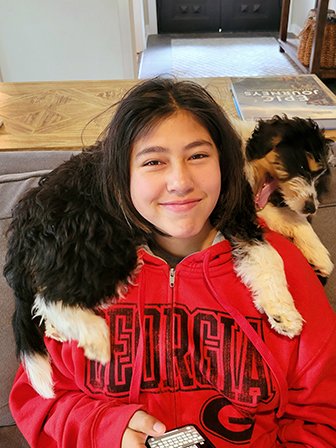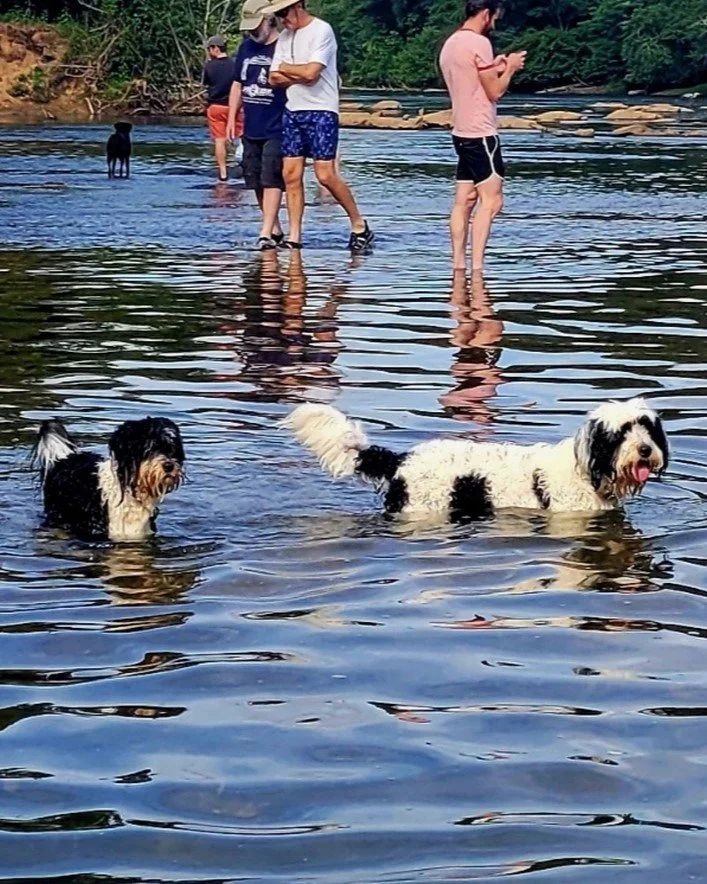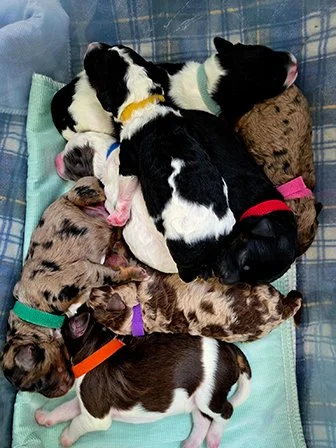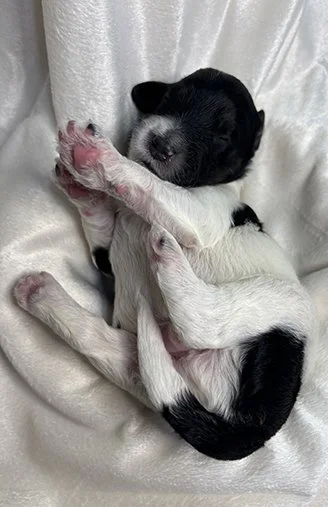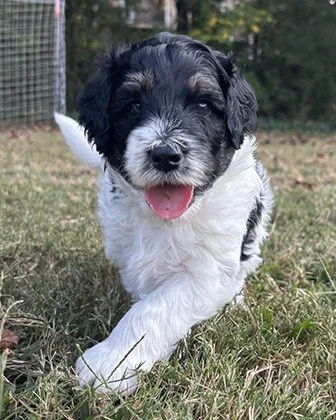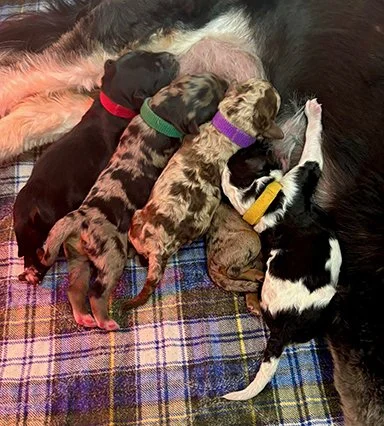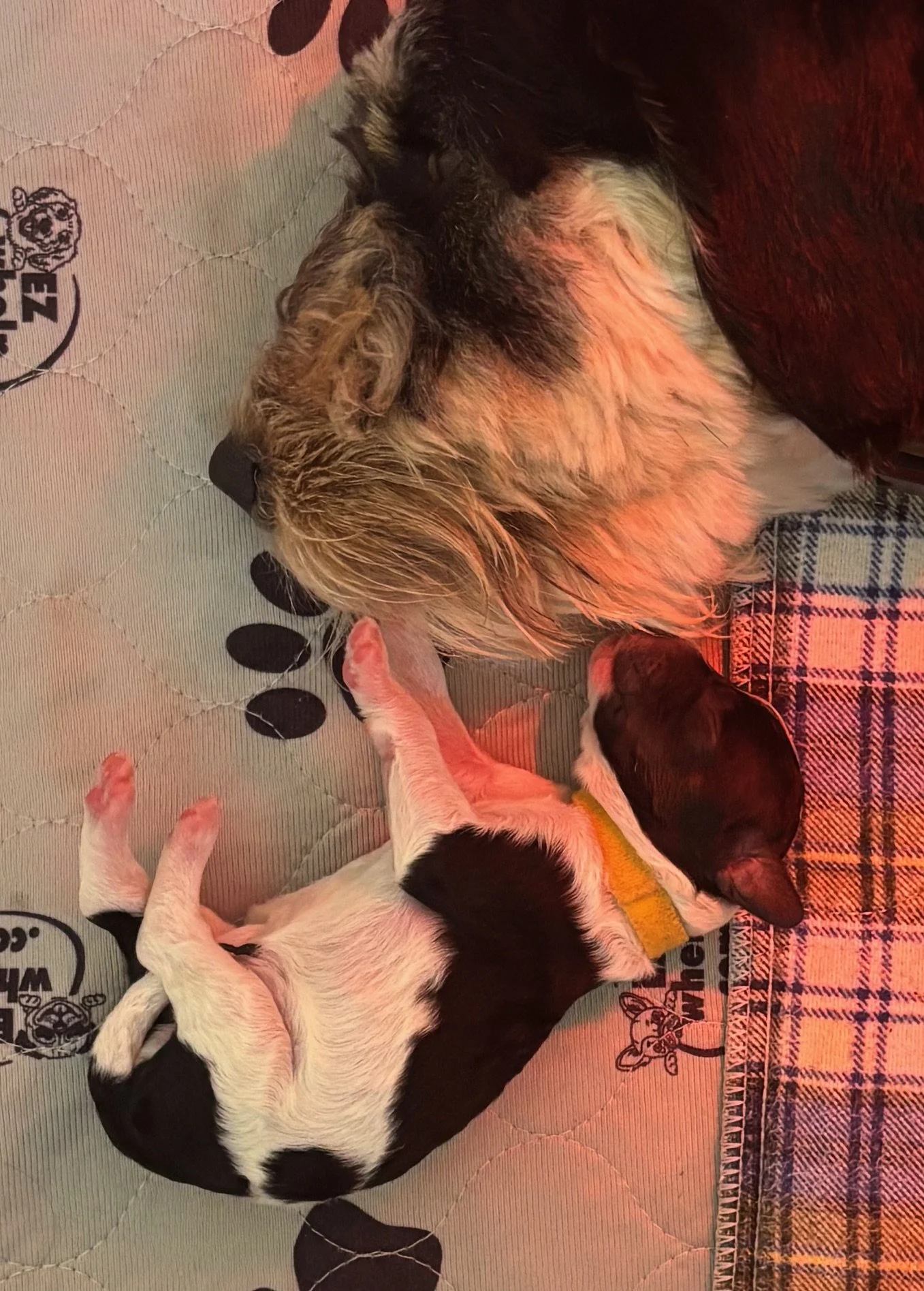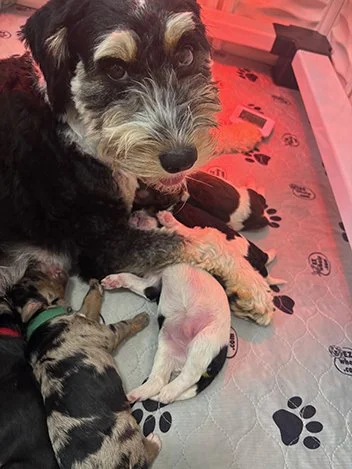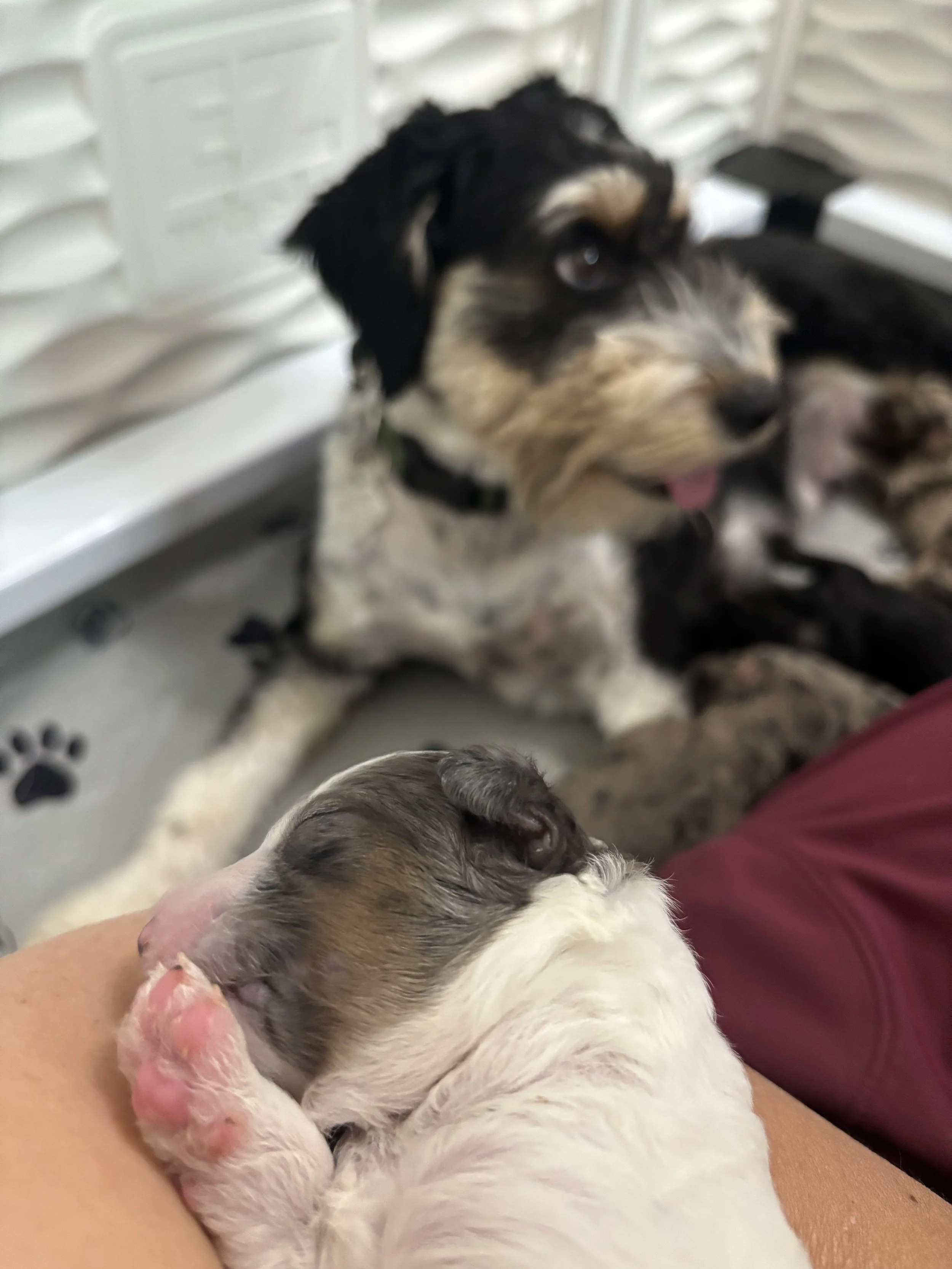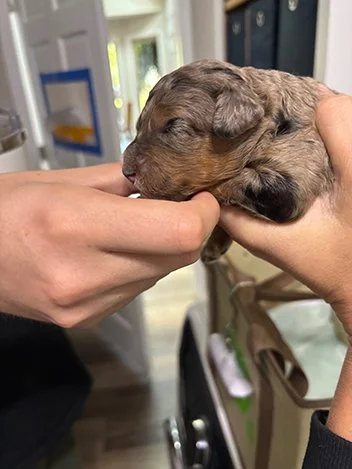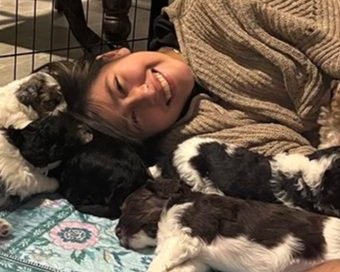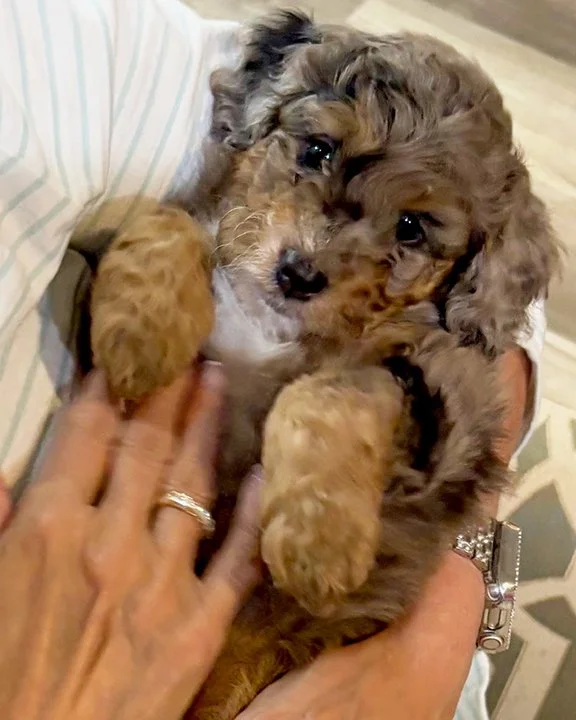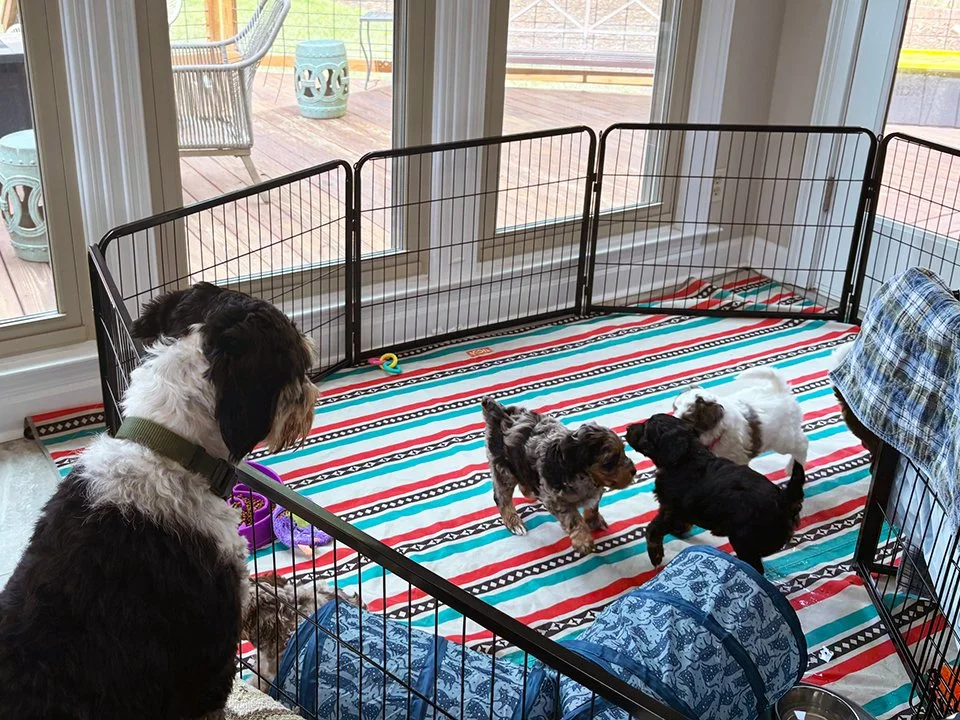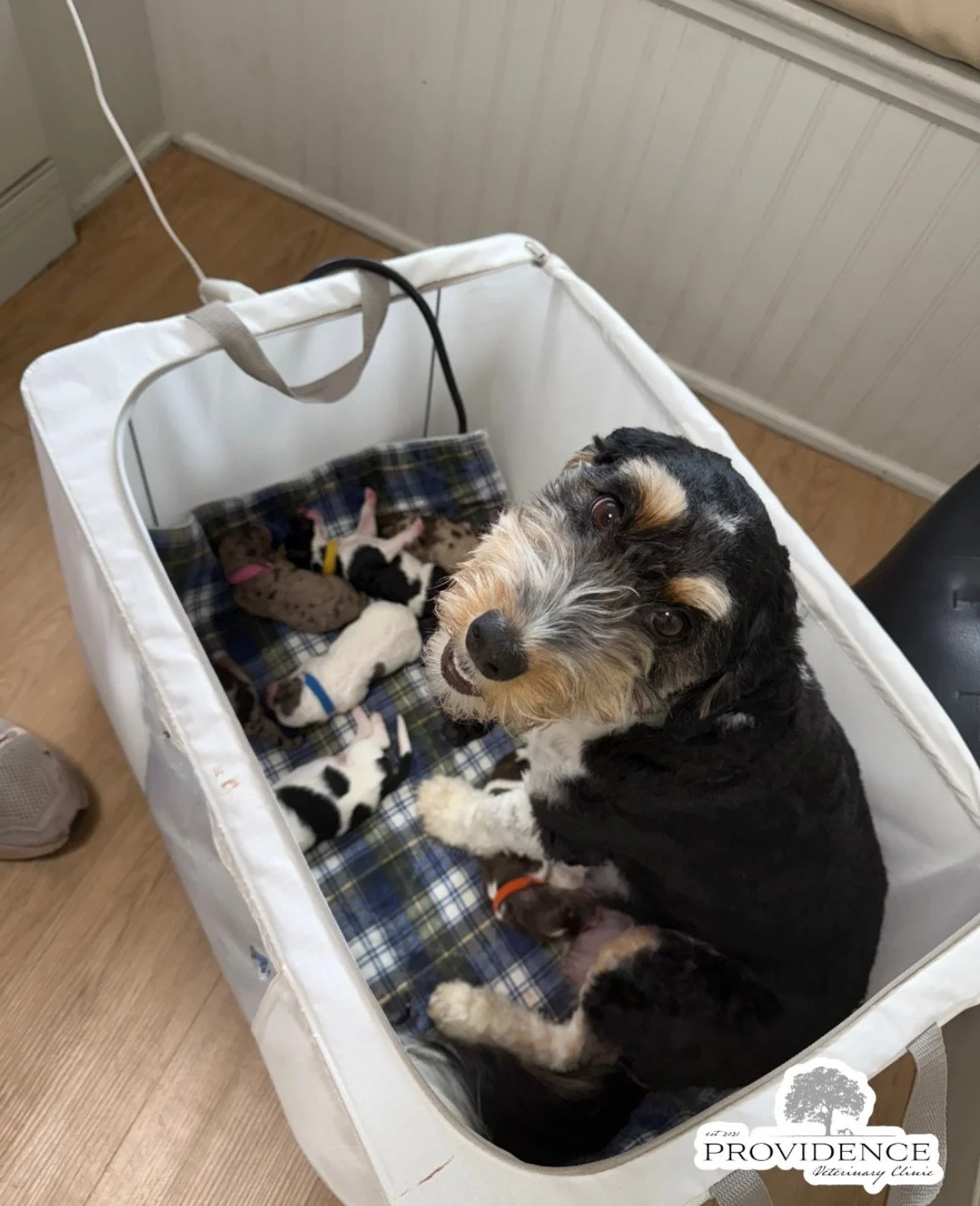How We Raise Our Pups & Care for our Pup Parents
A Day in the Life of a Dogwood Mama
The most important thing to know about us and our mamas is while our hearts have been taken over by our beloved family dogs Roxy and Elliot, as far as we’re concerned, any dog under our roof (mama dog, pup or visiting K9 friend) is treated as one of our own. We at Dogwood FD communicate only through positive reinforcement. Our job is to make all of our guardian mamas feel at home when they’re with us, maintain their relationship with their guardian families, and help their experience with us be a positive and enriching one. Part of this is to keep them healthy: we clean their spaces and groom them regularly with vet-approved cleaning and grooming brands, maintain appropriate vet visits, weigh them daily, track their temperatures as needed, and provide them with their needed food, vitamins and water to support their important work of staying healthy and growing pups. The other part is to keep them happy and their lives enriched, as explained in detail below.
We, Jimmy and Alison, have the privilege of being at home on the typical day and a network of experienced, dog-loving colleagues and family that help support us for the typical and atypical days. As such, our two beloved family dogs Roxy and Elliot, whether pregnant or not, enjoy every day multiple sniff walks or a longer hike, a romp to a neighboring field to run after balls and explore new smells, at least one brain stimulating activity such as learning new commands or enjoying a treat puzzle, multiple pets and lounging at our feet, the excitement of interacting with our stand-offish cat Nico, all capped off with an evening massage and prolonged snuggle time (this is as much for us as it is for them!). We spice up their weeks socializing with family and friends (K9 and human), visits to the river, mountains and the cute downtowns and restaurants near us, the occasional water fun in the back yard, and any other adventure that comes our way. We love doting on them and giving them new spaces to explore.
Pregnancy and pups does impact our mamas’ lives, but it doesn’t limit the enrichment that they get daily. It means that as a family, we don’t visit dog parks, we’re careful to interact only with dogs and people who have dogs that are up to date on their vaccines, and we steer away from sniffing manmade objects during sniff walks as they attract a ton of interaction from other dogs. We also follow the pregnant or mama dog’s cues in terms of energy level. This might mean that the more adventurous outings are replaced with many more sniff walks and brain stimulating activities. It’s important to keep her exercise up, but not to overdo it: growing pups inside and out is a big job already!
As a new mama, they spend the vast majority of their time with their puppies: nursing them, cleaning them and generally bonding with them. Roxy’s joy and pride was unmistakable! That said, the best mama in the world still needs some time away from their pups to follow the call of nature, exercise and decompress. This keeps her feeling her best and able to focus on her puppies for the long hours she’s with them. For this reason, we continue her breaks throughout the day, but generally limit them to 20 minutes at a time. As the weeks go by and the weaning process continues, the mama’s breaks naturally grow in length until the mama’s pups are ready to leave the nest for their forever home.
A Day in the Life of a Dogwood Pup
The first sixteen weeks are critical window to a dog’s development. This is the time when they learn how to bond, how to trust, how to understand the world, gain spatial awareness, confidence, independence from mama and their littermates, and the basics like eating, understanding the daily schedule, and growing comfortable with crates. This is also when they begin to practice patience, self-control, appropriate chew targets and command work through clicker training and positive reinforcement. Since we have them here for half that time, it’s our responsibility to instill within them the foundations to be a well-adjusted, happy and loving family forever dog.
Pups Days 1-2: Bonding
Whether a new mama or a pro, whelping can be an overwhelming experience. With multiple pups in your typical litter, pup mamas must multitask: caring for the ones born while actively birthing the next, or after whelping simply getting to know her new babes. We remain by her side throughout the entire whelping experience both for the health of all present, but also to help coach mama into her multitasking role. From whelping through the first several days, we check in on mama and pups frequently (but don’t intervene unless necessary for the wellbeing of all) to ensure that all are doing well in the whelping bed, their puppy safe den. Our support helps the initial bonding between mama and pup, crucial to setting these pups up for successful and meaningful relationships in the future, and to support Mama through this profound experience.
Whelping Day is a busy day for Mama and pups!
Day 2: adjusting to life as a proud new mama.
Pups Days 3-16: Gentle Handling and ENS (Early Neurological Stimulation)
Blind and deaf, the pups are just starting to feel their way through the world. It’s important at this stage to provide them with gentle handling to begin a trusting relationship with humans, and to jump start their neurological system through ENS (Early Neurological Stimulation).
Gentle handling starts first and foremost with gentle petting, holding against our hearts to feel the vibration, familiarizing them with our scents, careful snuggling and very basic grooming. As far as grooming goes, mama does 95% of the work, but we do begin trimming their nails with a gentle drommel. Why begin nail trimming at Day 3? Because those nails grow fast and sharp and it’s to keep us, them, mama and their littermates safe, and to desensitize them to the process early.
ENS is a set of five exercises developed by the US Military for their working dogs and promoted by the American Kennel Club. Observed benefits of ENS have been documented to include “improved cardiovascular performance (heart rate); stronger heart beats; stronger adrenal glands; more tolerance to stress; and greater resistance to disease” (AKC). It also gently increases their tolerance for stress, which is important to help prepare them for future playing with their siblings and new challenges, reduce future anxiety and build their own spatial awareness. For illustrations of the exercises, see the American Kennel Club.
Snuggling with 1-week old Natasha.
ENS with 1-week old Peggy.
Pups Day 17-Week 5: Puppy Kindergarten & Beyond
This is one of our favorite aspects of puppyhood! As their eyes and ears open, and their mobility increases, so too does their curiosity, play and sense of engagement with other pups, dogs and people. To build on the foundational work of ENS, we follow The Rule of 7s through our own Puppy Kindergarten, as well as behavioral work through routine schedules, clicker work, and positive reinforcement. At Day 17, they’re still adjusting to the new incoming sensory data of the world around them. For that reason, we start slow and very gently. As they grow, though, so too does their experience with Puppy Kindergarten and behavioral work.
Dogwood’s Puppy Kindergarten, also known as Puppy K., is a new puppy proof play space separate from their whelping bed. It’s modular in nature so that it can grow in size as the pups do, and can constantly change shape to adjust to different activities and keep things stimulating for the pups. Mama can easily come and go, or simply watch her little ones from a perch above. The pups still live in their whelping bed during this time, but they visit Puppy K. once or twice daily as well as go for field trips outside once a day for enrichment exercises that serve to expand their world and build their confidence, following the Rule of 7s.
The Rule of 7s is a socialization technique developed by Dr. Carmen Battaglia to build confidence, adaptability and trainability by exposing them to new stimuli in a controlled environment where they will have a positive experience. The Rule of 7 suggests that each pup be exposed to at least 7 new things in a given category by the time they’re 7 weeks old. We track our progress daily with the below goals aiming for at least 7, though some categories exceed that. We prioritize allowing the pups to figure out each new stimuli on their own time, but should a pup seem to need encouragement, such as climbing down a stair, we happily abide by turning ourselves into a joyful pup cheerleading squad.
7 substrates: e.g. hardwood, carpet, ice, grass, concrete, tin foil, plastic, tarp, blanket, dog bed.
7 sounds: e.g. laundry appliances, blender, ice maker, music & tv, birds, construction, cars.
7 types of toys: e.g. bouncing, teething, crinkly, rope, plush, puzzle, treat, squeaking.
7 food / water containers: e.g. plastic, ceramic, metal, elevated, floor, travel dog water bottle and travel dog food bag, human hand.
7 x 3 safe people & animals: 7 adults, 7 kids, 7 pup-friendly dogs (under careful supervision; it’s important that until the pups are vaccinated, they only meet vaccinated dogs).
7 challenges: e.g. maneuvering in and out of boxes, climbing a platform, going over obstacles, going up and down stairs, through tunnels, playing hide-n-seek, going around a blockade.
7 water experiences: e.g. puddle, bath, shower, kiddie pool, water toys, water pads, hose.
7 spaces to play: e.g. whelping bed, Puppy Kindergarten, kitchen, laundry room, back of parked car, outdoor exercise pen, nearby sports field (when unused).
7 spaces to eat: e.g. whelping bed, Puppy Kindergarten, kitchen, laundry room, person’s lap, crate, outside.
7 1-mile car rides: both with littermates and alone.
7 times in a crate: both with littermates and alone.
7 times away from mama and littermates: both within earshot and further away.
By 7 weeks of age, our pups will have had at least 77 unique and positive experiences in addition to the car rides, crate time and time away from mama and littermates. This prepares each pup for the new experiences, people, pets and environment of their future homes.
In parallel to the confidence building of the Rule of 7 comes behavioral work. We do this through a routine daily schedule for meals, Puppy Kindergarten and outings, familiarization with basic commands and clicker communication, rewarding wanted behaviors / ignoring unwanted behaviors, and teaching appropriate chew targets.
The routine daily schedule promotes a sense of security and trust in the pup that we will fulfill their needs, both physical and mental.
We introduce our pups repeatedly to several basic words. Although the commands of their forever family may differ, the idea that there’s a pattern between human verbal cues and wanted behavior will serve to make our pups that much more trainable. The basic words that we use daily include: come come, food, sit, stay, move move, leave it, down, playtime, beddy bye and shh for calming down. When the command is followed, even when accidentally, we reward with positive reinforcement through praise and clicker work. In addition to priming them for future training, these teachings also stretch them mentally and strengthen their bond to people.
At Dogwood, we reward all wanted behaviors with positive reinforcement. This includes clicker sounds, praise and continued playing with us. When they exhibit an unwanted behavior such as jumping on people, whining for attention, etc., we simply ignore them, delaying praise patiently until they exhibit a positive behavior. This technique always ensures that every interaction with us ends with a success for the pup and promotes a positive relationship with people. There are some unwanted behaviors that are painful, destructive or dangerous. For the first two, we simply use redirection. This is commonly seen with biting. When the pup tries to chew on us, we simply redirect to a chew toy. If they continue to revisit us as their target, we eventually remove ourselves from direct contact until they’ve turned their attention to something else. If there’s anything that’s dangerous, though, such as a wasp’s nest outside, we intervene immediately until the danger has been eliminated.
Pups Week 6-Adoption Day: Puppy K. Continues but the World Expands
At Week 6, the pups receive their first round of vaccines, and have become more mature, confident and curious. This gives us a chance to work on the more advanced elements of the Rule of 7s, such as puzzle toys, meeting several people at once and combining physical challenges into an obstacle course. It’s important to remember that while we continue to expand their world through the Rule of 7s, we do so carefully, to strategically build up their tolerance for stimuli at a pace that works for them, observing their behavior for feedback and following their cues.
At this stage, we also begin giving age-appropriate treats to reinforce the clicker work, though always in moderation. And towards the end of Week 7, we begin introducing them to harnesses and leashes.
Going Home
It’s important to remember that the training we provide during the pups’ time with us is a foundational start - a strong foundations start - but a start not the end. Each pup will need from their forever family continued patience, teaching and trust-building in order to grow into a well-adjusted, well-trained, and confident dog.
Should you need anything during your new-pup journey, we are here to support you, whether that be answering your questions or referring you to resources and / or experts.
Keeping Our Babies — Both Adult & Pup — Healthy
A healthy pup begins with mom and dad. We have all of our mama dogs tested genetically for hereditary diseases and compatibility with potential mates, and given a PennHIP exam to determine if there’s a predisposition for hip dysplasia and early onset arthritis. All papa dogs are required to provide the same testing.
Mama dogs are only allowed to reproduce starting at their second heat cycle. After their first litter, we require all of them to wait until their second heat cycle before mating again. This gives their body sufficient time to recover between pregnancies. We only allow each mama to deliver three litters at the most. They are given routine vet examinations before and after each litter to keep them and their babies healthy and safe, and determine if continuing in our breeding program is appropriate. If there’s any concern from the vet, the mama dogs are spayed and retired to live their best life with their guardian family.
During their pregnancy, mama dogs are given high quality vet-approved puppy food as well as a daily prenatal vitamin to support the fetal development, milk production and her own overall health. This diet continues through nursing, though the prenatal vitamin is replaced with specific for nursing. Moms are weighed daily throughout nursing to guarantee that they are eating enough for the calories they are expending growing their litter. Their temperature is also taken daily for the first weeks after birth in case of infection.
The puppies’ health is paramount. Their introduction to the vet begins with their first exam administered within the first two weeks, followed by their six-week visit for vaccines. During their time with us, we administer a broad-spectrum dewormer at our vet’s direction at two, four, six and eight weeks.
Similar to their mom, the pups are weighed daily to track their weight gain. If any track weight loss, vet-approved milk supplement is fed to that puppy by hand. If weight loss continues, immediate vet consultation is sought. The pups are slowly weaned and taught to eat first puppy mush and then the same high quality puppy, kibble as their mom. Both mush and kibble are vet-approved.
Since puppies cannot regulate their own body temperature for the first several weeks, the temperature of all spaces that the puppies occupy are carefully watched. Supplemental heat is provided as needed through pet heat pads and a heat lamp. Puppies also have their temperatures taken twice a day to ensure that their temperatures stay within a healthy range.
If any of our beloved dogs or pups show any signs of distress, we reach out to our vet or emergency vet immediately.
To support their health, we clean all spaces that they occupy as well as their linens, toys, food and water bowls, and accessories daily if not much, much more often.
Dr. Haley Domsky
Providence Veterinary Clinic
Dr. Haley Domsky
Providence Veterinary Clinic
Dr. Haley Domsky
Providence Veterinary Clinic
Roxy with her pups at their first exam.
Day 2 | Providence Veterinary Clinic




